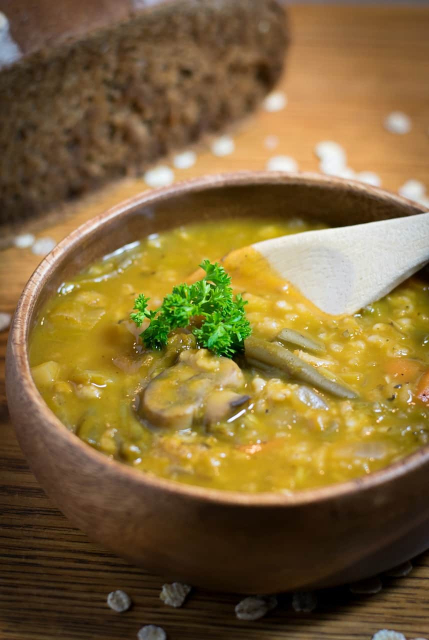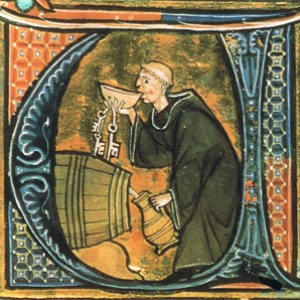I guess I could go on and on with plays on the titles of movies and books about the Middle Ages. But that’s not the real point of today’s post. As a slick segue from yesterday’s offering about ancient foods we still love, I humbly present a look at what they ate in the Middle Ages – versus what we thought they ate…

What do you envision when you think about supper in the time of Henry VIII? I get long, rough plank tables, pewter plates, endless flagons of wine, whole roast geese and suckling pigs, a whole roasted Boar’s Head at Christmas, and ‘conceits’ such as giant pies filled with live birds. They even wrote a popular rhyme about that one:
Sing a song of sixpence,
a pocketful of rye,
four and 20 blackbirds
baked in a pie.
When the pie was opened,
the birds began to sing.
Now wasn’t that a dainty dish
to set before a king?
But that vision is much more elaborate and luxurious than what the great, unwashed masses were eating.
Left: Pottage. A staple vegetable stew fort the Medieval masses.
A curiously healthy diet – in some ways
One of the obvious drawbacks to the Medieval Diet was the belief that breakfast was the least important meal of the day. To eat breakfast was considered committing the sin of gluttony. And the Church was a power second only to the King himself in those days.
Another faux pas of the day – which is easy for us to see with 20-20 hindsight – is that raw vegetables were not safe to eat. So they cooked everything. Cooked the living bejaysus out of it, by all accounts. And that, as we know now, destroyed a lot of the food’s nutritional value. Meat was very rarely available to the lower classes. Vegetable stews and soups were, thus, a mainstay of the poor folks’ diet.
The crucial importance of Bread
Bread was the centre of the Medieval Diet’s universe. Everybody ate it, and some folks at the lowest rungs of the social ladder ate only bread and weak ale for some meals. At that time, bread was baked in small loaves about the size of a modern kaiser roll. One loaf was a meal for one person. Because bread was so crucial to the Medieval diet, bakers were among the most privileges of tradesmen. They formed the strongest unions and wielded a fair amount of power. Want to pressure the government to do something? Threaten to stop baking. If they did, millions would starve, and there would be a revolution.
The political and economic importance of bread was still in unchallenged when Queen Marie-Antoinette allegedly triggered the French Revolution. The king’s ministers told their majesties that the peasants had no bread. She’s famously (though apocryphally) reported to have enraged just about everybody by replying, “Then let them eat cake!”
Alcohol was more than recreational
The world – especially the cities – was such a filthy place in Medieval times that nobody drank plain water. Most drank a weak ale or beer made from fermented barley malt. The alcohol therein killed most of the germs. Many folks brewed their own beer and there was rarely any shortage within the average village. in larger settlements, some folks specialized in brewing and opened their homes to the thirsty. The concept of the public house, or pub, survives to this day, though malting and brewing are now mainly industrialised. Near the end of the last century, the idea that pubs should brew their own quaffs was revived by a strong grassroots movement called the Campaign for Real Ale (CAMRA) which succeeded in having what we now know as brew pubs and boutique breweries legalized.
In the higher strata of Medieval society, people had the option of more expensive and more varied alcoholic beverages. They were mainly grape- and fruit-based wines and, rarely, included distilled grain-based products such as brandy or whisky.
Wine, particularly, was believed to have medicinal powers (not the least reasons for which were probably its ability to kill germs even better than beer, and ‘soothe the savage breast’). The doctrine of the day is nicely summed up in the King James Bible, in 1 Timothy 5:23, where the apostle Paul is reported to say: “Drink no longer water, but use a little wine for thy stomach’s sake and thine often infirmities.”
Whole grains were the rule
Grains were processed minimally and, aside from separation of the chaff, consumed ‘whole’. Aside from bread, grains were most generally consumed as porridge. The single most popular version was oatmeal, which remains a huge favourite around the world today. An estimated 6 percent of the world’s population eats oatmeal daily. That may not sound like many, but it’s still about 480 million people. And over an average year, they consume more than 23 million tonnes of it.
It appears that Medieval cooks came by accident upon a dietary principle that in the past few years, has gained new acceptance. The current editions of the official daily dietary recommendations from virtually all developed countries call for eating more whole grains – whether as cereals, porridge, breads or whatever.
A chequered legacy
So… The Medieval times bequeathed to us an odd collection of dietary legacies: from eternal oatmeal to the British public house. And it’s worth noting that thee best of the Medieval diet came from the common folk, not the privileged few who are most often commemorated in art from the period.
I know a couple of folks who have embraced Medieval culture as a hobby. They’re fairly highly placed in the worldwide Society for Creative Anachronism (SCA). From them, I have a souvenir cookbook of authentic Medieval recipes researched by a university anthropologist of my acquaintance. It’s titled Dagger Licking’ Good. You won’t find it on Amazon anymore – unless author Shelly Rabinovitch and Raymond’s Quiet Press decide to reprint it. If you’re interested, let me know and I’ll arrange to reprint a few of the recipes here…
~ Maggie J.

